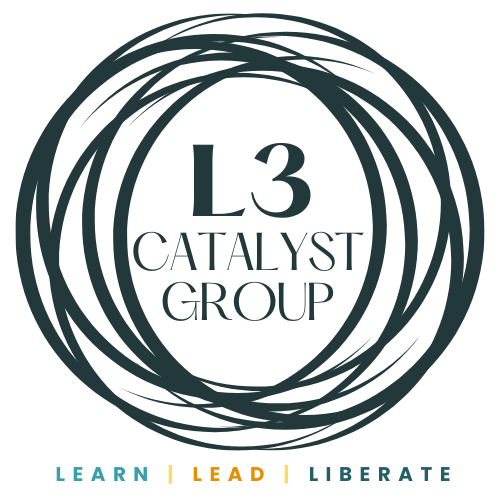Leading by Example
Today, we hear from Ken Miguel-Cipriano, a brilliant, brave, and badass human, Director of Public Agency at West Michigan Center for Arts + Technology (WMCAT).
Over the last few weeks, we've heard from leaders in our series unpacking the three Ls of L3 Catalyst Group: Learn, Lead, and liberate.
At L3 Catalyst Group, we believe that leadership is intention in action. Everyone can be a leader, irrespective of one's formal position. Leadership is significant and complex. It embraces conflict and is grounded in personal and organizational commitments, values, and vision for change. Addressing this complexity requires everyone's engagement to do their own work for the collective whole.

Heartfelt thanks to you, Ken, for sharing your wise reflections on leadership.
Fellow leaders and learners, I wish you courage, rest, and beloved community along the journey.

 When many of us hear about leadership, we think back to our first boss, someone who was assigned to us and us them. Some of us get lucky and are assigned to a boss who is also a leader. They guide us through our first job and build us up for the role and for what is to come.
When many of us hear about leadership, we think back to our first boss, someone who was assigned to us and us them. Some of us get lucky and are assigned to a boss who is also a leader. They guide us through our first job and build us up for the role and for what is to come.
Leadership goes beyond merely managing a team; it inspires and empowers individuals to reach their full potential while collectively working towards a shared vision. So, what does good leadership look like, and how can you cultivate these traits to be a better leader in your professional and personal life? Let's explore some essential qualities and practices that define good leadership.
1. Effective Communication: The Cornerstone of Leadership
Communication is the bedrock of effective leadership. A good leader possesses exceptional communication skills that include active listening, clear articulation of ideas, and an understanding of non-verbal cues. Communication isn't just about talking; it's about creating an open and inclusive environment where team members feel heard and valued. Regular team meetings, one-on-one discussions, and providing constructive feedback are vital aspects of effective communication that help align everyone toward a common goal.
2. Empathy: Building Bridges and Fostering Relationships
Empathy, the ability to understand and share the feelings of others, is an essential trait of a good leader. A leader's empathy towards their team builds camaraderie and trust. Leaders need to recognize and acknowledge their team members' unique experiences and emotions, paving the way for meaningful connections. Understanding the challenges and triumphs of your team members allows for better decision-making and the implementation of policies that support the well-being and growth of individuals and, ultimately, the organization.
3. Leading by Example: Integrity, Humility, and Accountability
I believe the most influential leaders are those who lead by example. Demonstrating integrity, humility, and accountability in actions and decisions sets a working example for everyone to follow. Integrity means being reliable, trustworthy, and accountable for one's actions. Humility means acknowledging mistakes, learning from them, and valuing the contributions of others. Accountability involves taking responsibility for one's actions and their consequences. When leaders embody these qualities, they create a culture of trust, respect, and credibility within the team and organization.
Good leadership is a continuous journey of growth and self-discovery. It involves mastering the art of effective communication, embracing empathy, and showcasing integrity, humility, and accountability. By incorporating these qualities into your leadership style, you can inspire and motivate your team, foster collaboration, and ultimately achieve success professionally and personally. A great leader is not only defined by their accomplishments but also by their positive impact on the lives of those they lead.

 What Ken is Reading:
What Ken is Reading:
- Inclusive Transportation: A Manifesto for Repairing Divided Communities by Veronica Davis
- The Power Broker: Robert F. Moses and the Fall of New York by Robert A. Caro
- Big Magic by Elizabeth Gilbert
- (re-reading) Between the World and Me by Ta-Nehisi Coates
 L3 Catalyst Group Blogs Related to Learning & Leadership:
L3 Catalyst Group Blogs Related to Learning & Leadership:

November 2, 2023




Comments